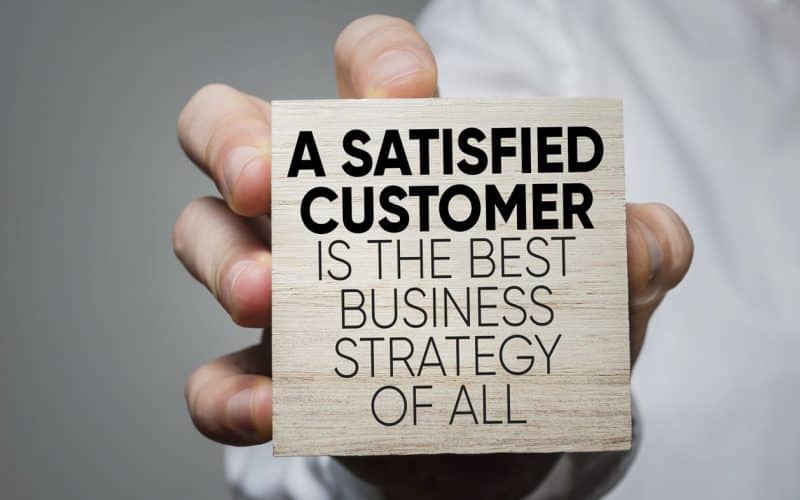A well-thought-out sales strategy plan lays the groundwork for an efficient and effective sales team. It also helps keep salesmen happy and effective by aligning them around common goals and providing them with the tools to do their great job. Using the information in this manual, you should be able to increase your sales leads and convert a higher percentage of them. So, read on to learn about an example of a sales strategy plan and the types of sales strategy presentation.
What Is a Sales Strategy?
A sales strategy is a well-thought-out approach to marketing and providing a service or good to a targeted audience. This is done in a way that stands out from the competition and generates a positive return on investment. The purpose of developing a sales strategy is to offer your sales team well-defined goals and direction. Sales plans often outline important data such as revenue targets, key performance indicators, target customers, sales channels, team composition, a SWOT analysis of the competition, marketing strategy, and sales strategies.
Furthermore, the majority of these suggestions can help you and your sales personnel talk about the same things. Most sales approaches fail because they concentrate too much on the inner workings of your business. What a salesperson says, does, and writes to establish credibility and build value is the communication factor that determines success or failure. The success of your company’s sales strategy depends on engaging in meaningful dialogue with customers. These expertly conveyed exchanges are what sets your organization apart from the rest, impress your customers, and help you close the deal.
Example of Sales Strategy
A little bit of sales strategy is similar to a tiny bit of salt: thus, it can go a long way. This is also true for smaller companies that lack the resources to promote themselves. However, with some imagination, even a modest enterprise can achieve great success. You can use any one of these five tried-and-true sales tactics to boost your company’s bottom line or combine them for a comprehensive advertising campaign. Thus, the example of sales strategy include:
#1. Power-Based Principle
When using this example as a sales strategy, the salesperson positions themselves as the industry authority. If a salesperson is tasked with assessing a situation, providing all the necessary knowledge, and following up with a solution, there is no need to contact customer service, development, or engineers.
Apple serves as a prime illustration of this. You might not know much about this if you’ve never been to an Apple store. Customers are greeted by “Apple Geeks” whenever they enter an Apple retail store. These are the experts who can answer any question about the product. They are well-versed in everything Apple has to offer and can make a quick sale to you thanks to their extensive knowledge.
#2. The UPS Way of Selling on Value
Value-based selling has become a common example in the sales strategy business world. This is the method by which your offerings and the value that customers place on them are positioned. To sell in this way is the polar opposite of focusing solely on the good or service itself. Care more about the result than the means to it.
In addition, UPS excels at this sort of thing. They are one of the largest transport and logistics firms in the world, and they face tough competition. However, they seek to sprint ahead of their rivals by adding an additional layer of value to their goods and services.
#3. Risk-free Trials
This is also another example of a sales strategy to get people interested in your product. They are useful for generating leads because they reveal which customers are considering purchasing your goods. Free trials are effective because they give prospective consumers a risk-free opportunity to test out your goods or services without spending any money. So, if you run a digital subscription model, you may, for instance, provide a free trial period of several days to potential new users.
#4. Discounts
Offering price reductions is yet another effective strategy for attracting new customers. They attract new clients by providing a price break for potential buyers. If you run an online store, you might, for instance, provide new consumers with a discount of 10% on their initial purchase.
#5. Referrals
Encourage your happy clients to spread the word about your company by giving them exclusive deals in exchange for word-of-mouth promotion. Customers that are actively seeking a solution to a problem will naturally gravitate toward this type of inbound sales approach. (In contrast, an outbound sales approach involves actively seeking out potential clients via means such as cold calling or email marketing.)
Types of Sales Strategy
Several types of sales strategy exist for various industries. The following are types of common sales strategy used across several sectors:
#1. SPIN Selling
The goal of SPIN selling is to create meaningful connections between salespeople and potential customers on an intimate level through conversation. The main purpose of SPIN, despite asking many questions and learning about the prospect’s requirements first, is to make it difficult for the prospects to abandon the sales cycle.
#2. Consultative Selling
This is one of the most successful types of sales strategy today because it allows salespeople to present themselves as a reliable and trustworthy resource for their customers.
In addition, consultative selling, as its name implies, calls for salespeople to take on more of a consulting role. It also entails talking to customers about more than just the products and services they’re trying to sell. So, if a salesperson is trying to convince someone of something without having first-hand knowledge or experience, they will need to perform an extensive study.
#3. Get Familiar With the Product
The expert trying to sell you something must be completely familiar with it. It doesn’t matter what sector or market an item is sold in, a knowledgeable salesperson is essential. So, if you don’t know what your product can do for your clients, you won’t be able to respond to their questions or concerns. Good product understanding requires intensive training.
#4. Knowing the Client
Identifying the customer is also one of the types of sales strategy. A salesperson must have a deep understanding of his target market because consumer tastes vary widely between industries. He must understand everything there is to learn about the client. This includes what the customer loves and doesn’t like about the items he’s already using, why he uses those products, and how his product can replace those products.
#5. Incorporate Visuals
While it is the salesperson’s responsibility to explain the product’s advantages, the buyer must see those advantages put to use. First, the salesman must guarantee that a thorough display of the product was given to the consumer. As not all consumers are capable of comprehending a product’s explanation in just words, a demo is crucial for closing sales.
Sales Strategy Plan
The following steps will be useful as you develop your sales strategy plan:
#1. Make an Approach to Increase Demand
Here, users must lay out their strategy for reaching out to their ideal customers, whether through paid advertising procurement streams, content marketing, in-person events, or any other means.
#2. Evaluate the Efforts of Both Individuals and Groups
It’s time to start keeping score! After the foundation has been laid, a system must be established to monitor progress at the personal, group, and organizational levels. Half-yearly key performance indicators, per-week charts, month-to-month reviews, or a hybrid of these are all viable options. In this section, you should also detail which statistics the group should prioritize.
#3. Create a Vision for the Organization
Most sales teams automatically set goals because it’s common sense. How else can you be sure you’re doing what needs to be done to achieve your goals? When setting sales targets, it’s important to work across departments. Since everyone in the firm is ultimately responsible for the bottom line, it’s important to solicit feedback across the board.
#4. Keep Tabs on Sales Activities
Keeping tabs on your activities is crucial if you want to improve your methods for future expansion. Set team goals even if you’re merely beginning, and record your progress toward them. The initial sales pitch and the closing strategies used should be recorded. Make sure that any link you share has a UTM tag so that you can monitor how many people click through from social media or your published influencer content.
You may want to see: SALES PLAN: Job Description, Skills & Salary
Sales Strategy Presentation
If you want to make sure your sales strategy presentation is in line with those of the other partners in your organization, then you should give a presentation outlining your sales approach. You should utilize this opportunity to discuss how you want to establish, educate, and grow your sales department. This is done to capitalize on the prospects you believe will assist your firm in getting more clients. Below are ways to create a compelling sales strategy presentation:
#1. Discover Your Unique Selling Point
It’s easy to get preoccupied with customer avatars and revenue targets before figuring out what sets you apart from the competition. Put that in the forefront of your mind when thinking about how to make a sales strategy presentation.
#2. Maintain Brevity
The sales staff doesn’t need a comprehensive visual representation of their funnels. Keep each presentation to a minimum in terms of text and numbers, and only include the most crucial details.
#3. Lay Out Your Marketing Plan
Which markets do you plan to focus on? While it may make sense to focus on one industry sector, more often than not, your sales strategy presentation must be designed to meet the needs of consumers across a variety of marketplaces. This will allow you to reach a wider audience and provide more people with access to your products and services.
If you can pinpoint the organizations that invest the most in your market segment, targeting them with your sales efforts will generate more revenue and accelerate your results. However, this is acceptable so long as you employ the appropriate approach and equip your staff with the tools they need to succeed.
#4. Provide an Account of Development and Training Efforts
Invest in your team’s training and growth so that you can achieve your goals. Most sales managers fail to see how their team’s performance directly impacts the firm’s ability to implement its plan. Hence, without proper training, you run the danger of not implementing the approach effectively enough to achieve your goals.
#5. Discuss Budget Needs
Finally, there are costs associated with changing strategies, education and training, and developing advertising resources and technologies. In addition, in some situations, bringing on board a team of experienced individuals to implement your strategy, is another example of what you could spend money on. Ensure your sales presentation includes a discussion of the financial resources you will need.
What Are the 4 A’s in Sales?
Acceptability, Affordability, Availability, and Knowledge are the 4 A’s. “The 4A paradigm stems from the consumer standpoint that emphasizes the four specific roles which clients perform in the industry.
What Are 7 Steps of Sales Strategy?
They include:
- Prospecting.
- Preparation.
- Approach.
- Presentation.
- Dealing with objections.
- Ending.
- Follow-up.
What Is Key Sales Strategy?
A sales strategy is a plan of action that details how your company and its goods will be presented to potential buyers. It’s a roadmap for salespeople to follow, with specific goals in mind for sales activities, product placement, and market analysis.
How Do You Plan a Sales Strategy?
A successful sales strategy identifies customers existing problems and demonstrates how well the service or product can alleviate those pain points. This also includes the core demographic, ideal client character, and customer profiles, techniques, and platforms.
References
- blog.hubspot.com
- corporatevisions.com
- encharge.io
- similarweb.com






